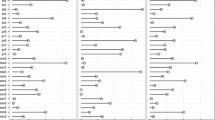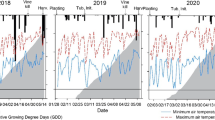Abstract
Using data from an 11-year period, total and marketable yield were related, using regression analysis, to mainstem and tuber number for five maincrop varieties (Russet Burbank, Shepody, Atlantic, Norchip, and Norland) and two early-maturing varieties (Conestoga and Carlton), at irrigated and dryland sites in western Canada. Mainstem number by itself was a poor predictor of total and marketable yield. Highly significant regressions of yield on the derived variable tuber number per mainstem were evident for all cultivars grown at the dryland sites. In general, the proportion of the total variation in yield accounted for by the regression models was much higher at the dryland than at the irrigated sites, indicating that the relationship between yield and its predictor variables was more complex for irrigated sites. While the study suggests that the use of tuber number per mainstem may be useful as an early-season predictor of tuber yield for cultivars, particularly under dryland conditions, a model using the predictor variables mainstem and tuber number will generally be superior due to the additional information it provides when competitive effects are present for light energy within the canopy or for assimilates among developing tubers. Contour plots provide a useful way to study the yield response to changes in tuber number at specific stem density levels.
Resumen
Usando análisis de regresión en un período de 11 años para evaluar los tallos principales y el número de tubérculos de cinco variedades principales (Russet Burbank, Shepody, Atlantic, Norchip y Norland) y dos variedades precoces (Conestoga and Carlton), de zonas irrigadas y de secano del oeste de Canada, se encontró una relación entre los rendimientos totales y comerciales. El número de tallos principales por sí mismo era un pobre indicador del rendimiento total y comercial. En todos los cultivares cultivados en zonas de secano se hizo evidente una regresión altamente significativa del rendimiento en la variable derivada del número de tubérculos por tallo principal. En general, la proporción de la variación total en los rendimientos contabilizados por los modelos de regresión fue mucho mayor en las zonas de secano que en las irrigadas, lo que indicaba que la relación entre el rendimiento y sus variables de pronóstico era más compleja para las zonas irrigadas. Si bien el estudio sugiere que el uso de número de tubérculos por tallo principal puede ser útil como un pronóstico precoz del rendimiento de tubérculos por cultivar durante la temporada, particularmente bajo condiciones de secano, un modelo que use las variables de tallo principal y número de tubérculos como predicción, generalmente será superior debido a la información adicional que proporciona cuando están presentes los efectos de competencia, por la energía de la luz dentro de la canopa o por asimilaciones entre los tubérculos en desarrollo. Las parcelas de contorno proporcionan una vía útil para estudiar la respuesta del rendimiento a los cambios en el número de tubérculos a niveles específicos de densidad de tallo.
Palabras claves: Rendimiento de tubérculo, número de tallos, número de tubérculos, Russet Burbank, Shepody, Atlantic, Norchip, Norland, Conestoga, Carlton.
Similar content being viewed by others
Abbreviations
- STEM:
-
mainstem number
- TYLD:
-
total tuber yield
- TNUM:
-
total tuber number
- MYLD:
-
yield of > 55-mm tubers
- MNUM:
-
number of > 55-mm tubers
- TPS:
-
total tuber number per stem
Literature Cited
Allen, E. J. 1978. Plant density. In: Harris, P.M. (ed), The Potato Crop-The Scientific Basis for Improvement. Chapman and Hall, London. pp. 278–326.
Bleasdale, J.K.A. 1965. Relationships between set characters and yield in maincrop potatoes. J Agric Sci 64:361–366.
Draper, N.R. and H. Smith. 1981. Applied Regression Analysis. 2nd ed. John Wiley and Sons, Inc., New York.
Goodwin, P.B., A. Brown, J.H. Lennard, and F.L. Milthorpe. 1969. Effect of centre of production, maturity and storage treatment of seed tubers on the growth of early potatoes. II. Field Growth. J Agric Sci Camb 73:167–176
Gray, D. 1972. Spacing and harvest date experiments with Maris Peer potatoes. J Agric Sci Camb 79:281–290
Holmes, J.C. 1973. Relationship between stem number and tuber number in the potato crop. Proc. 5th Triennial Conference, Eur. Assn for Potato Res, Norwich.
Irritani, W.M., R. Thornton, L. Wilier, and G. O’Leary. 1972. Relationships of seed size, spacing and stem numbers to the yield of Russet Burbank. Am Potato J 49:463–69.
Love, S.L., C.V. Eberlein, J.C. Stark, and W.H. Bohl. 1995. Cultivar and seedpiece spacing effects on potato competitiveness with weeds. Am Potato J 72:197–213
Lynch, D.R. and R.G. Rowberry. 1977. Population density studies with Russet Burbank. I. Yield/stem density models. Am Potato J 54:43–56.
Lynch, D.R. and G.C.C. Tai. 1985. Yield and yield component response of eight potato genotypes to water stress. Crop Sci 29:1207–1211.
Mead, R. and R.N. Curnow. 1983. Statistical Methods in agriculture and Experimental Biology. Chapman and Hall, New York.
Rex. B.L. 1991. The effect of in-row seed spacing and harvest date on the tuber yield and processing quality of Conestoga potatoes in southern Manitoba. Can J Plant Sci 71:289–296.
SAS Institute, Inc. 1989. SAS/STAT User’s Guide, version 6. 4th edition. SAS Institute Inc., Cary, NC.
SAS Institute, Inc. 1990. SAS/GRAPH software: Reference, version 6. lst ed. SAS Institute Inc., Cary, NC. Sharpe, PR., and J.B. Dent. 1968. Determination and economic analysis of relationships between plant population and yield of main crop potatoes. J Agric Sci 70:123–129.
Snedecor, G.W. and W.G. Cochran. 1980. Statistical Methods. 7th ed. Iowa State University Press, Ames, Iowa.
Willey, R.W. and S.B. Heath. 1969. The quantitative relationships between plant population and crop yield. In: Brady, N.C. (ed), Advances in Agronomy, vol. 21. Academic Press, Inc., New York. pp. 281–321.
Wurr, D.C.E. 1974. Some effects of seed size and spacing on the yield and grading of two maincrop varieties. I. Final yield and its relationship to plant population. J Agric Sci Camb 82:37–45.
Author information
Authors and Affiliations
Corresponding author
Rights and permissions
About this article
Cite this article
Lynch, D.R., Kozub, G.C. & Kawchuk, L.M. The relationship between yield, mainstem number, and tuber number in five maincrop and two early-maturing cultivars. Am. J. Pot Res 78, 83–90 (2001). https://doi.org/10.1007/BF02874763
Accepted:
Published:
Issue Date:
DOI: https://doi.org/10.1007/BF02874763




